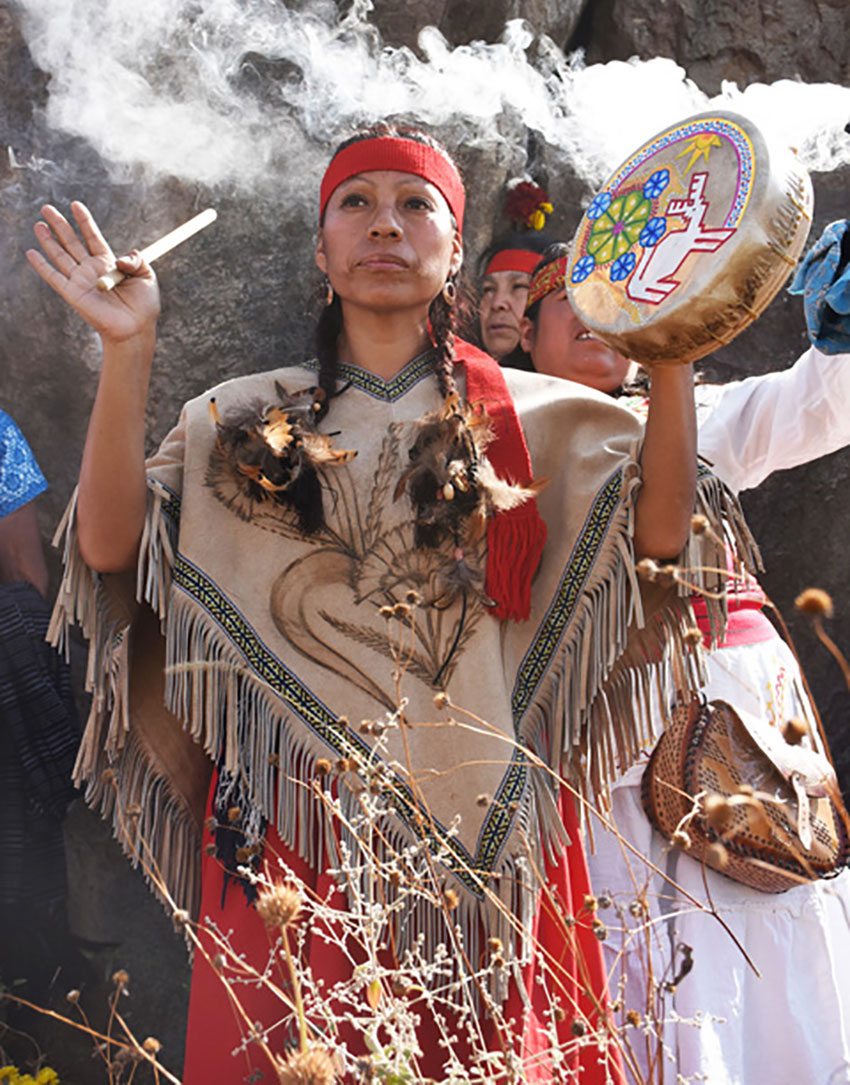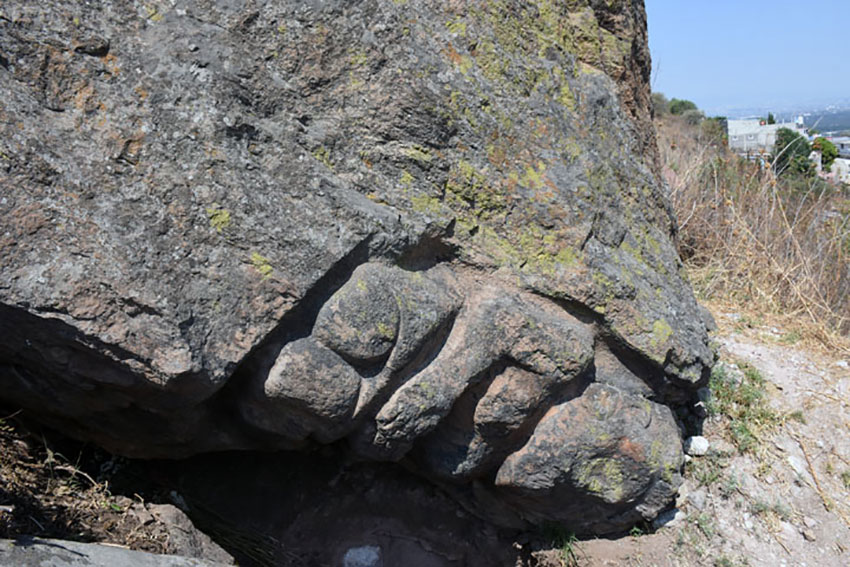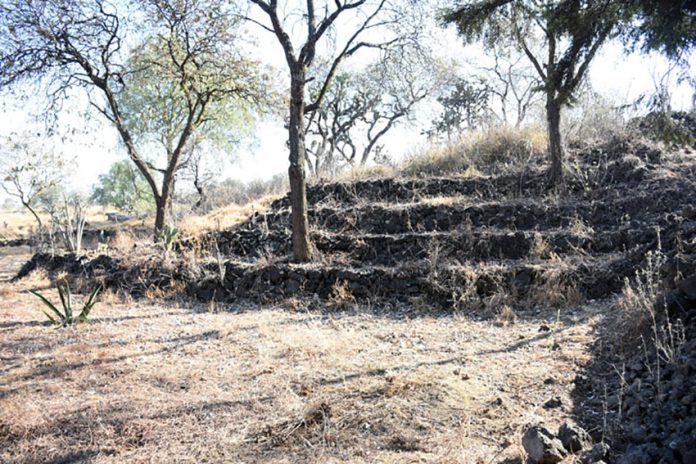San Gregorio Atlapulco is a pueblo originario, an original pueblo, which means it has held onto its indigenous traditions. Every major fiesta in the Mexico City pueblo features Aztec dancers and drummers, and usually several groups of them.
Pilgrimages are taken yearly to places like the Villa Guadalupe in Mexico City and Chalma in the state of México and although both are now recognized as Catholic shrines, they were originally important indigenous religious sites, something most people undertaking the pilgrimages are aware of.
Virtually all Catholic ceremonies held during the year have indigenous underpinnings and symbols, and all are examples of the pueblo’s deep indigenous roots. But perhaps what most clearly shows those roots are the unexcavated ruins in the nearby hills.
Javier Márquez Juárez, who has researched and written about the ruins and is an expert on all things pertaining to San Gregorio, has taken me there many times. We always find something new.
Juan Rafael Zimbron, an archaeologist who has also visited and written about the ruins, said they span different eras, from the pre-classic to post-classic. “That is to say, there are some that are 2,000 years old and others that are 700 years old, depending on the location and the designs.”

The structures and carvings found there contain elements of the Teotihuacán, Xochimilca and Mexica (Aztec) civilizations.
Two of the most striking elements in these ruins are the monoliths located on the crest of a hill called Xilotepec, giant carved boulders depicting a priest of the Mexica god Xipe Totec (at least one archaeologist believes the carving is of Xipe Totec himself) and the other depicting a fertility goddess.
Xipe Totec was the god of agriculture, spring and war (among other things) and he faces east to greet the sunrise. The figure is depicted wearing the skin of a sacrificial victim, which symbolizes rebirth. Next to him is a carving of the Mexica fertility goddess, Cihuateteo (locals call her La Malinche, the name given to the indigenous woman who aided the conqueror Hernán Cortés).
She’s kneeling with her hands clasped around her stomach which, according to María Teresa Herrera Ortiz, the director of the Museo Antropología Xochimilco in Santa Cruz, symbolizes pregnancy. This monolith lies on its side. “It was knocked down by Spanish friars in the 18th century, probably around 1770,” said Márquez Juárez. “The friars found that residents of the pueblo, and especially pregnant women, continued to perform rituals there.”
The friars may have thought that knocking her down would stop the rituals but they were wrong. Flowers are still placed on or around the monoliths as offerings and rituals are sometimes performed by curanderos, traditional healers).
Not far from the monoliths are temazcales (sweat lodges) and these structures — many of them still standing — are found throughout the ruins, indicating that parts the area were most likely used for religious ceremonies. There are also structures that appear to have been used as observatories, some that may have been houses, and at least two small pyramids.

There are many carved stones scattered among the ruins that Márquez Juárez and archaeologists who have viewed them believe are maps that in some cases may show the locations of wells and lakes. Often, there are carvings on the rock’s face that depict the terraces (still extant) built into the hillsides and used for planting.
Small to medium-sized holes (called positas) are almost always found on top of these stones. It’s believed that liquids — either water or the blood of sacrificial victims — were poured into these wells. The liquids then flowed down over the carved terraces in a ritual aimed at ensuring a good harvest.
One day, Márquez Juárez was walking alone through the ruins and misstepped, hurting his knee. He sat down on a rock to assess the damage — fortunately, he was all right — and when he looked closely at the stone on which he sat found that it was carved with a cruz puntada, a dotted cross. Such crosses are found in Teotihuacán and other Mesoamerican sites and were used for astronomical purposes.
Another large rock he found is carved with two concentric circles which, according to a book by Eric Saloma García and Nadia Leon Guzmán, might represent water or, possibly, snails. Such symbols are found around the world and are among the oldest symbols yet discovered, the ones in Central Asia dating back 4,000 years. They’ve been interpreted as representing the sun, symbols of reproduction and the universe.
The ruins cover a very large area. Márquez Juárez and I have walked through them for up to four hours and there are certainly carved stones and structures yet to be discovered. Unfortunately, this may not happen because the ruins are deteriorating. Some of that is simply due to the elements wearing down the stones over hundreds or even thousands of years but much is also due to people destroying structures.
“Sometimes people will take stones from a structure because they need to build something for themselves,” said Márquez Juárez. “Sometimes they will destroy something because they believe it is evil; there are many superstitions.”
Sadly, the Institute of Anthropology and History simply doesn’t have the funds to preserve the multitude of ruins spread across the country. It’s particularly distressing in this case because this was clearly an area that was dedicated to Xipe Totec, an important Mexica god.
Also, Márquez Juárez is convinced that the site was where tributes from conquered tribes were brought before being sent on to Tenochtitlan, the Aztec capital.
Joseph Sorrentino writes from his home in San Gregorio Atlapulco. He is a regular contributor to Mexico News Daily.
